#what was more culturally significant the renaissance or this
Explore tagged Tumblr posts
Text
“You were saying you didn’t even know what love feels like and I was just thinking, you idiot, you asshole, it feels like this.”










ninety one whiskey by komodobits
#what was more culturally significant the renaissance or this#i’ll be thinking about this line forever#ninety one whiskey#91w#spn#supernatural#destiel#dean winchester#castiel#on my 91w brainrot shit atm#i downloaded these from pinterest idk who to give credit to i’m sorry :(#the inside of my brain
102 notes
·
View notes
Text
which was more culturally significant; the renaissance or the queer-coded arthuriana adaptation that is bbc’s merlin?
#this is from the deep depths of 2022#but i stand by what i said#two years later#i know what was more culturally significant to me#and let's just say#it was not the renaissance#bbc merlin#merlin#bbcm#bbc#bbc's merlin
28 notes
·
View notes
Text
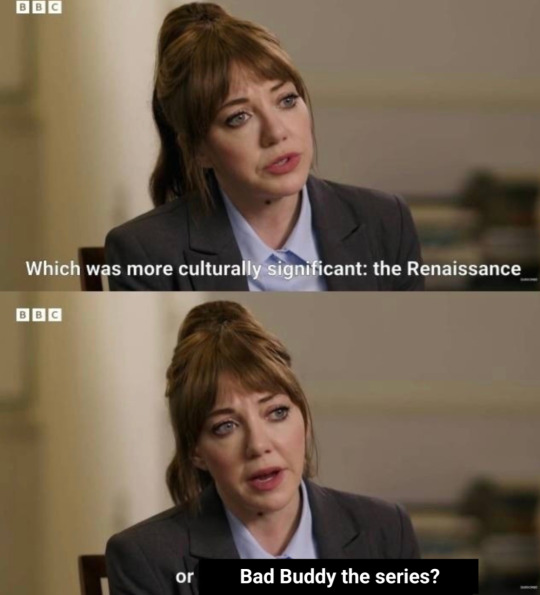
#im sure this has been done before#but heres my contribution to bad buddy insanity#bad buddy#bad buddy the series#bad buddy memes#patpran#what is more#culturally significant#the renaissance#or bad buddy#who knows#certainly not me#i vote bad buddy though
322 notes
·
View notes
Text

What’s more culturally significant the Renaissance or Greta Gerwig & Florence Pugh?
#greta gerwig#florence pugh#hollywood#iconic#women#girl power#feminism#whats more culturally significant#The renaissance or this#favorite white women
9 notes
·
View notes
Text
You see a lot more post apocalyptic stories set in the US or Canada or Australia than you do in the old world, and I’m going to go out on a completely unsupported limb and argue that that’s because part of what the genre is doing is allowing us to imagine an almost historicizing vision of these modern countries: there never was a feudal or renaissance United States. There were no nomadic conquerors in Australia. The prior history of these places was radically different from the contemporary periods in the old world and the eradication of native cultures allows popular culture to imagine that prior history as being a long, quiescent void, so the desire to tell stories in an archaizing version of modern North America causes people to reach forward past a posited apocalypse. Versus in Europe or China or India where you can just set stories in a historical period.
That’s not the only urge that postapocalyptic stories appeal to but I think it’s a significant one.
278 notes
·
View notes
Text
what was more culturally significant. the renaissance. or seatbelt.
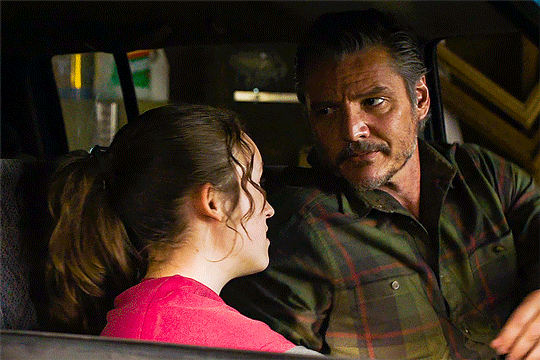
#this was such a paradigm shift#I will look at a seatbelt in the car and weep as I think about Them#seatbelt is platonic love language 😤🖐️#‘no matter you you keep finding something to fight for’ well I fight for seatbelt til my last breath#if seatbelt has a million fans I’m one of them#if seatbelt has five fans I’m one of them#if seatbelt has one fan that one is me#if seatbelt has no fans I am no longer of this earth#til my last breath I’ll support seatbelt#the last of us hbo#joel miller#the last of us#ellie williams#pedro pascal#tlou#bella ramsey#tlou hbo
3K notes
·
View notes
Text
Stede Bonnet, Renaissance Man (Or an Exceptional Man who Thinks He’s Mediocre)
I’ve posted before about Stede’s love of beauty. He’s an aesthete, finding wonder in art and creative self-care rather than the transcendental. Stede’s a freethinker. He challenges the orthodoxies of his time, rejecting forced heteronormative behaviours, and even questioning the accepted traditions of piracy.
The thing about Stede is he often asks ‘why?’ It’s partly what makes him dangerous to some. This slant towards subversion is much of what Izzy observes and detests. It’s one of many reasons Stede must be kept from Ed. Like a number of Renaissance-style thinkers before him, Stede refuses to go along with the status quo. He is ‘doing something original’, questioning dogma. Many find it ridiculous, bizarre even. And it’s significant that instead Ed finds Stede enchanting, because it demonstrates who Ed might be given the chance to find his own path.


Stede is also a polymath and likely an autodidact - I doubt he learned about ‘insane foliage’ at school. He is self-motived and seems to have knowledge across a broad spectrum of disciplines. Literature, drama, botany, entomology, psychology, art, textiles. Stede’s very much about the life of the mind.


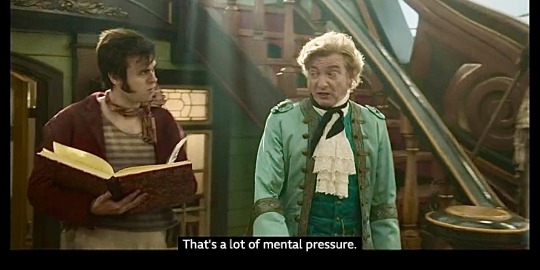
And he’ll approach areas at which he’s not so gifted, such as cartography and sword-fighting, with the enthusiasm of a dilettante; when he can’t succeed the traditional way, he simply subverts the discipline and does it his own. However, the most important thing for me in defining Stede as a Renaissance man is his humanism. People are front and centre. Sometimes that person is himself, and he loses sight of others. But it’s okay as that’s the point. Humanism is partly about being a messy individual who can do better. And Stede is someone who can learn and alter his position when circumstances change. He might not do so in the best way all of the time, but he is a quick-learner and highly-adaptable.
Stede also understands that no culture or institution is bigger than the people within it. The most important thing is human dignity - it’s what he shows and teaches Ned’s crew: that they deserve to be respected as people. Stede also has a strong moral core. When he messes up, he feels it deeply. He demonstrates strong ethics towards the natural world too - he’s absolutely disgusted by turtle vs. crab. Stede believes not so much in human superiority, but human responsibility, and this is the flip side of having dignity as a human being.
Another aspect of Stede’s humanism is his belief that culture should be accessible to all. Some of this might be naivety on Stede’s part rather than a well-thought out philosophy, but he believes in it intuitively. Stede wants the crew to have access to his library despite not recognising they can’t all read. He gives them musical instruments and sports facilities - he’s interested in what makes people flourish. And Stede practically invents art therapy!


His ship is also a safe-space for human relationships to blossom - romantic, platonic, and in between. Zheng’s ship might appear to offer collective harmony, but it’s mandated and dogmatically applied. Opting out of morning tai chi for a 24-hour shagathon might be viewed as an act of dissent. No such big brother is judging you on Stede’s Revenge.


And all of this is because of the man Stede is, and the influence he has on those around him. Sometimes it falls on deaf ears. Many don’t like what Stede’s offering. Others actively rebel against it. But anyone with an ounce of goodness will get what Stede Bonnet is about and embrace it. Stede doesn’t seem to understand his own power, it comes from such an authentic place. For me, it makes him all the more endearing.
229 notes
·
View notes
Text
What was more culturally significant:
The Renaissance...

Or Taika Waititi's portrayal of a queer Blackbeard?

2K notes
·
View notes
Text
what was more culturally significant - the renaissance or 'he never did fall in love again."
#the way i sobbed in the last couple of chapters should never be spoken about again#i finished art heist baby last week and i still haven't quite recovered#i didn't notice the major character death tag until it was too late#ii know the right answer isnt the renaissance#art heist baby#marauders#starchaser#sunseeker#jegulus#james potter#regulus black#rosekiller#wolfstar#dorlene#marauders era#slytherin skittles#dead gay wizards#dead gay wizards from the 70s#hang painting here?
223 notes
·
View notes
Text
reblog for the fandometrics!!!
285 notes
·
View notes
Text
Which was more culturally significant: The Renaissance, orrr *that one* moment in Marvel Cinematic Universe?
Reblog with what you think, I'll go first:

This entire comic con appearance from 2013.
#marvel#renaissance#comics#loki#deadpool#deadpool 3#tom hiddleston#comic con#kevin feige#mcu characters#reblog this
400 notes
·
View notes
Text
Just a quick reminder of something, because I saw people talk about this on recent posts...
So, I made a TON of posts explaining why it is important to remember that the Roman gods are not the Greek gods per se - as in, the Romans had a different view and perception of the Greek gods, and so ended up creating yes, mostly equivalents and counterparts to the Greek gods, but with their own religious and cultural significance slightly different from the Greek deities - each culture having its focus on a different thing. (Aphrodite became more of a motherly and national goddess, Hermes became suddenly very merchant and commerce obsessed and not much of a thief anymore, Poseidon's rule extended to all waters not just the sea, Ares became a god of peace and agriculture?) Etc, etc.
However I now see people taking this way further than it should. I am not surprised because that's what people do on the Internet, you tell them one thing and they extrapolate it all.
But so you know, the difference between Greek and Roman gods is only valuable and interesting by the times of the Ancient Greek and Romans themselves.
When you go by the Renaissance, or by the modern eras that followed it, you'll notice that all paintings and books and sculptures are about the Roman gods - Jupiter, Juno, Neptune, Venus, Mercury, Vulcan and whatnot. Does it mean they are about the Roman gods? NOT AT ALL! They're all about the Greek gods mainly, but mixed with some Roman elements.
That's something some people are apparetly not aware of, so I'll try to briefly summarize it for ya... By the Middle-Ages, people knew of what we call today the "Classical mythology" mostly and mainly through the Roman texts and authors. Later by the Renaissance some of the Greek texts and authors were rediscovered, shared around and used a lot - not all though, as the rediscovery of Ancient Greece would be slow and steady, and we still find new fragments of Greek texts today! But here's the gist: the Roman texts and legends having been there before the Greek ones in people's cultures and heads... By the Renaissance and forward, the Roman names of the gods were the one used by default. For them these names were the famous and recognizable ones, and almost the "truest" of their names... Even when depicting entirely Greek myths and legends.
Because that's the subtle trick of Renaissance and all that would follow: the Greek texts and legends being THE big piece everybody was talking about and discussing about, the gods depicted in the arts and fiction by these eras were mostly and mainly their Greek versions. But, due to the "I was here first" and pre-eminence of the Roman literature and culture in Europe, these Greek identites and personas of the gods were refered to by their Roman names, and the Greek myths coexisted with the Roman legends. And that's the whole point: throughout the history of modern Europe, the difference between Roman and Greek god does not matter because they were conflated and unified into one and same set of entity, and people didn't care about the difference.
Which is what led to today's belief that "Roman gods are just the Greek gods by a different name" - and also led to stuff like this horrible thing I experienced as a teenager when the teacher supposed to teach us about Latin, when talking about the Roman gods, just handed to us a description of the Greek gods and told us to just swap the Greek names with the Roman ones (this teacher was an AWFUL awful teacher, not mean, but very bad at her job).
Because yes, that's the irony: you'd think that because people were more familiar with Roman mythology and the Romans personas of the gods during the Middle-Ages and the Renaissance, the Roman gods would have overshadowed the Greek ones, but in effect that's the reverse. The Roman gods being erased by the Greek gods: which is why people still think today Mars is a bloodthirsty war god, or that Minerva has all the attributes of Athena, or that Mercury was just as much a god of thieves as of legal business. The main problem today isn't to highlight the purely Greek things - because the Ancient Greeks have won this historical battle. The problem is pointing out how the Roman gods had their own unique thing on the aside that the Greek gods did not.
In conclusion: yes, you can use paintings of Jupiter to illustrate an article about Zeus, because at the time they were made, the artist probably was thinking about Zeus but just used a different name.
#it might sound complicated#but really it is so simple#the roman gods are not the greeks gods#yet the roman gods *became* the greek gods through time#greek mythology#greek gods#roman gods#roman mythology
57 notes
·
View notes
Text
IWTV S2 Ep1 Musings - Daciana: History through Visual Context in Ploiești, Romania
I immediately fell in love with The Vampire Daciana & her Romanian castle, and wanted to know more about it all.
We already know how much the set/costume designers on IWTV looooove attention to detail; they tell whole stories just through architecture, furniture, clothes, etc. So I was like OK, AMC, I see you; lemme start doing some reading up on Romania, so I can try to figure out what might be going on with Daciana. (Warning: I know eff all about Romania or Eastern Europe.)
ROMANIA
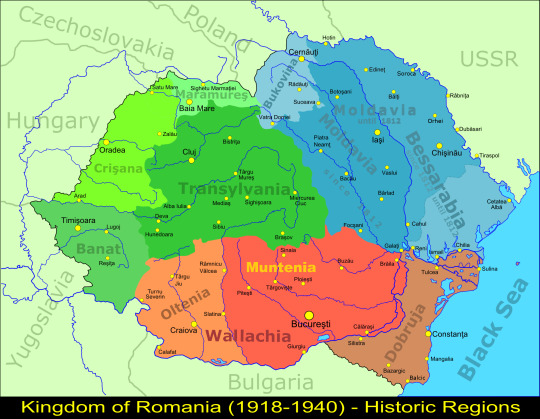
Map of Romania. Ploiești's the dot just under Muntenia, north of Bucharest, the capital. Ploiești's part of Wallachia, the IRL kingdom of Vlad Tepes (aka Dracula). Louis & Claudia went there in the 1940s, so I hope this map is accurate enough. (There's this map, but I dunno the date.)
DACIANA
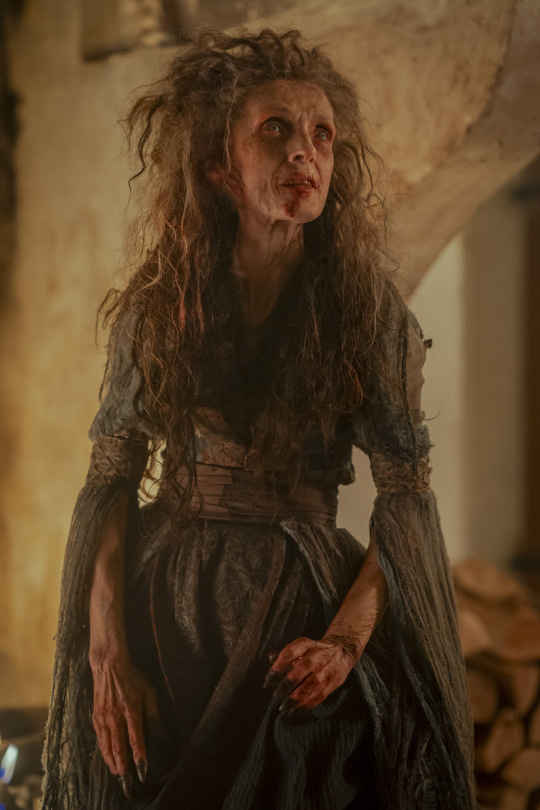
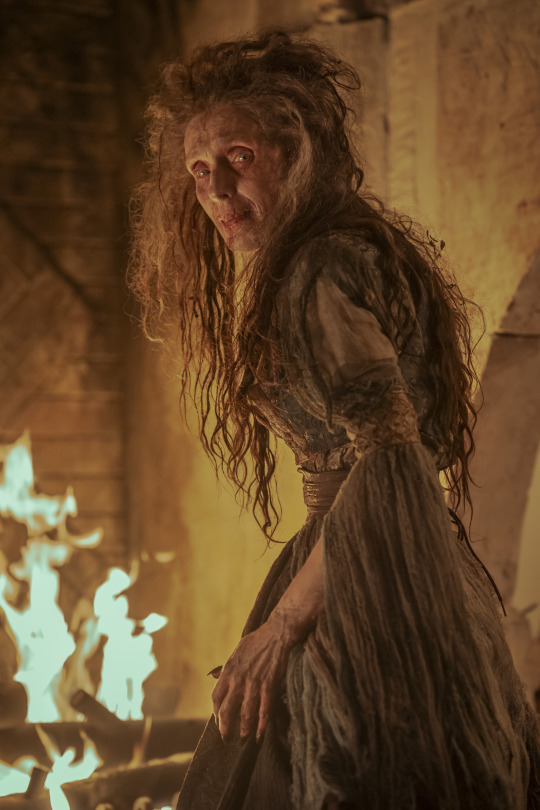
The most obvious thing about her is that she's not dressed in the typical traditional Romanian folk clothing I see all over Google, full of white-red-blue/black palettes.
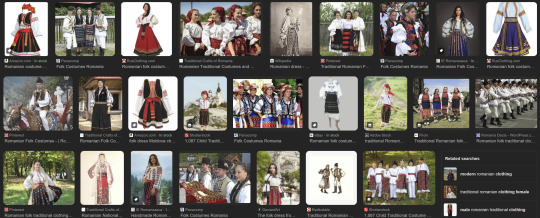
Daciana's not following traditional 19th/20th-century Romanian nationalist images. Her green/brown palette & silhouette is telling, as she lacks the puffy white blouses & dark skirts. (Despite her name, I'm ruling out her being Dacian (X X)--you think you're FUNNY, AMC! But IDK about Cezare Romulo (X X); might do a Pt2!)
Sleeves
First thing's her trailing slashed open sleeves, which were screaming Medieval! at me. Here's some 15th century Renaissance examples, but with surcoats, which is different, but the sleeves reminded me of hers so IDFK.
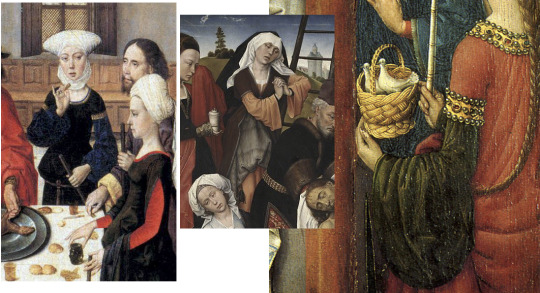
We could chalk this up to Daciana's design as just generic "medieval" fairytale stuff and keep it moving. But to give her a fair shake, I looked at local examples for anything similar that's more recent.
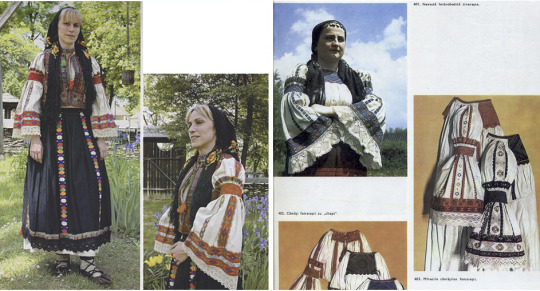
Traditional clothing from Huedin, Romania (north Transylvania), (X X).
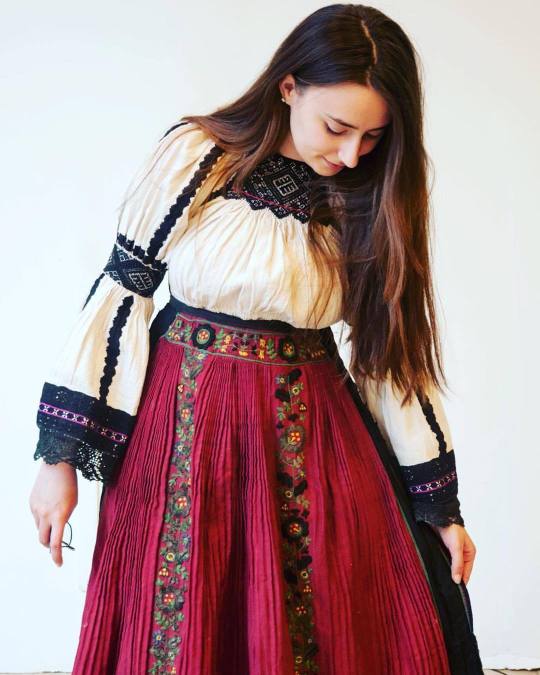
Traditional clothing from Cluj, Romania (north Transylvania).
Keep Transylvanian/Muntenian cross-cultural contacts in mind when we get to Daciana's castle, cuz it's important!
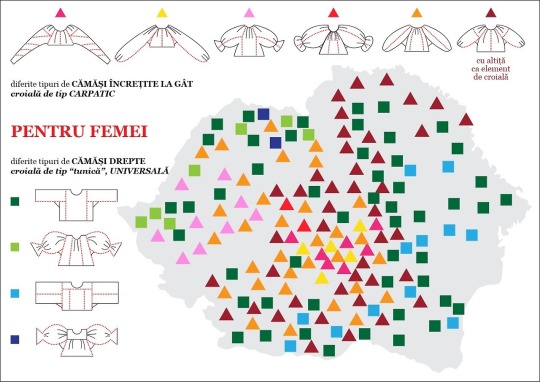
Wrt rarer non-puffy sleeves, the square cut (light blue) seems to be more prevalent in Wallachia/Moldavia/Bessarabia (southern & eastern Romania); while the rectangular cut (dark green) is all over Romania, but definitely has a concentration in Wallachia & Moldavia.
And this makes sense, cuz the style seems to also be prevalent in 19th - 20th century Bulgaria, just south of Wallachia. Hrm....
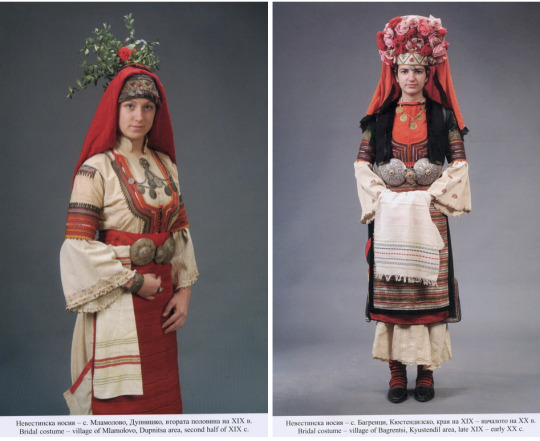
Daciana's sleeves hang very long--the only example of super long sleeves I could find is a 19th century one at the Met (C.I.47.3.4a–d). The only example of slashed sleeves I could find is in this museum exhibit at Bran Castle (yes, THE Bran Castle--I'll get to it in a minute!)
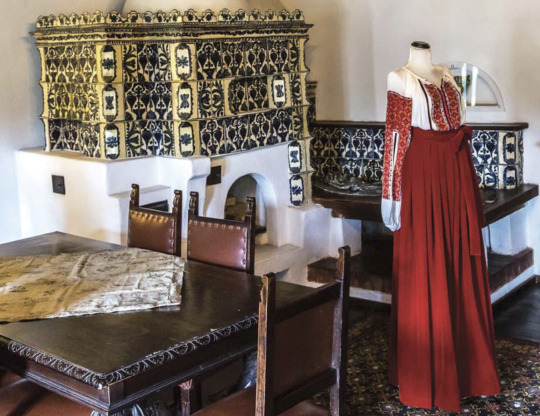
Belt, Bodice, & Fabric
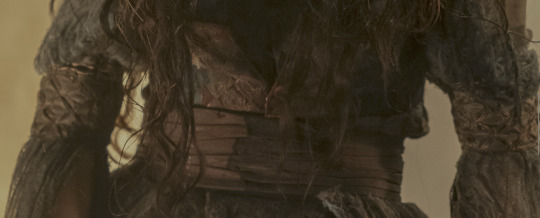
Daciana's belt is so plain compared to everything else. Is it supposed to be a leather Romanian chimir (worn by mountain/forest folk)? Those are only worn by men though? Or it depends? Or is it a just a plain cloth belt? It's reminding me of these examples (X X):
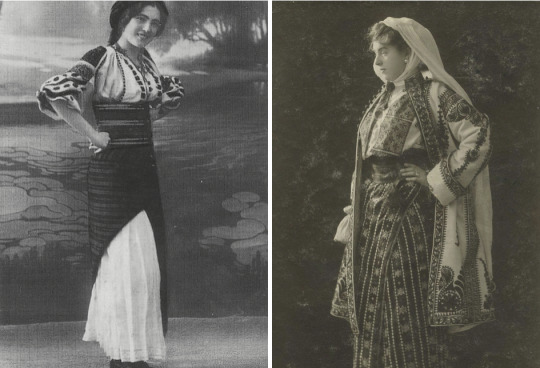
I wish I could see more of Daciana's bodice, if there's any particular kind of cut or patterns. Is the diamond netted/knotted/roped pattern on her arms significant? Her fabric is interesting, too:
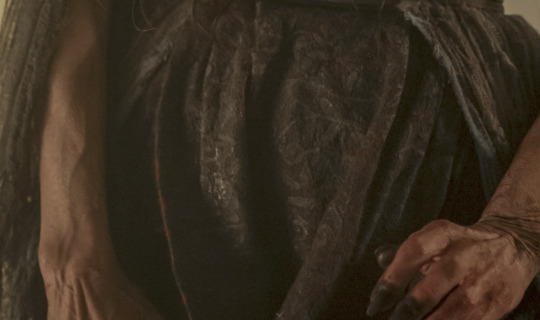
What's this embroidery? Brocade? (Byzantine-Renaissance?) Damask? (c. 14th-16th century?) Lace? Something else? My brain wants to assume it's imported? Meaning: she's hella rich. Cuz like, the traditional Romanian blouse & skirt used to belong solely to peasants, b4 19th-20th century aristocrats started wearing it, too.
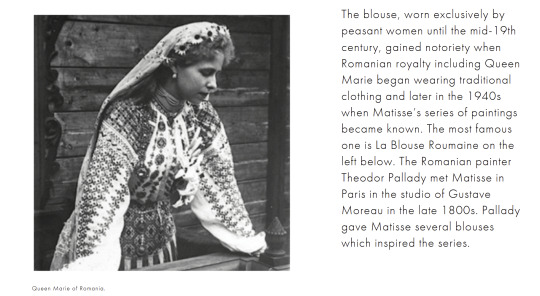
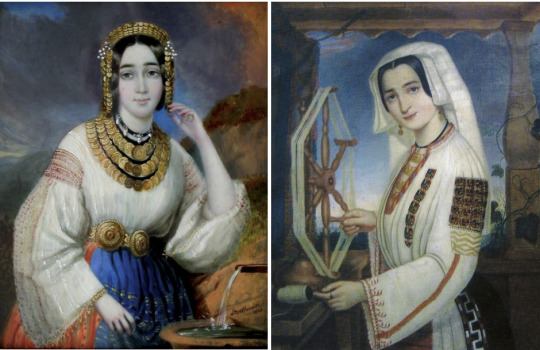
IDKY--more reading led me to a whole bunch of complicated stuff, that can probably be simplified by just saying: The Ottomans. XD
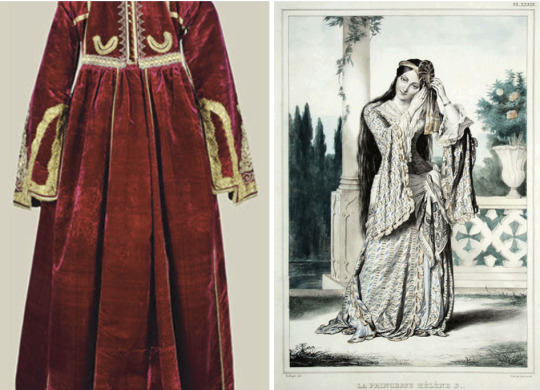
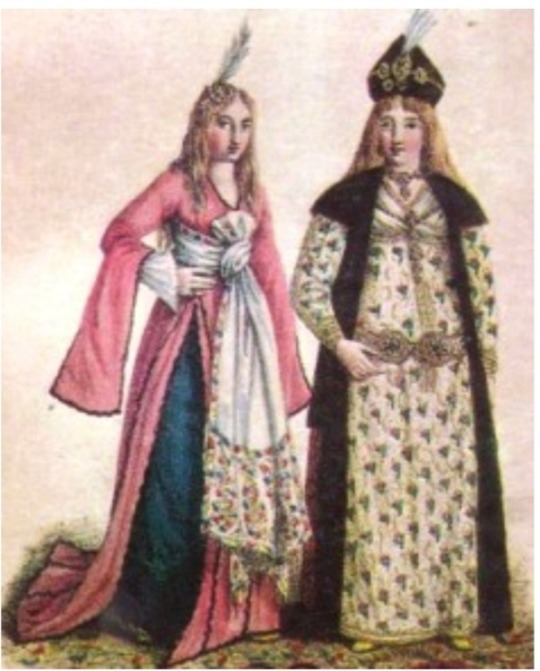
The pre-19th century Romanian aristocracy wore super opulent clothes, inspired by not just the Ottomans (X), but also the Byzantine Greeks (via 18th century Romanian Phanariote boyars (X X X)), etc. But aside from the hanging sleeves, Daciana's dress doesn't really resemble any of these foreign examples. However, it does track with my theory that Daciana predates the 19th-century Romanian nationalist/traditional clothes that became so iconic later on.
Like Louis & Claudia did, let's follow Daciana to her castle! ^0^
DACIANA'S CASTLE
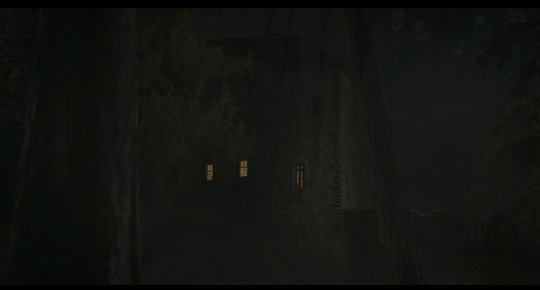
I NEED to know if AMC filmed on location in Romania, or if Daciana's castle is just a studio set/green screen.
The interior's nowhere near what I expected, considering Daciana's haggard appearance. It's really nice--clean & tidy. No spiderwebs, no chipped plaster/paint, not even any bloodstains--but I've mentioned before that I think it's indicating that Daciana's a mother who takes better care of her home (and "child") than herself.
Archway
The first thing is the arch when they first come in (noticeable mostly cuz of how Louis had to bend down to get in, he's so tall).
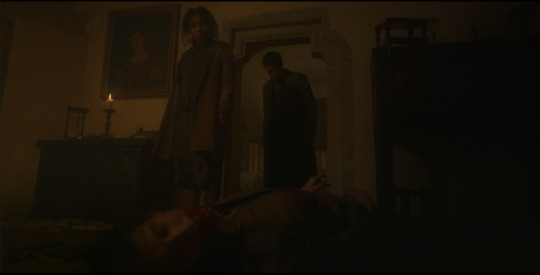
These types of doors/arches are called "shouldered arches," dating from the Medieval-Gothic periods, which Europeans adapted from Islamic architecture during the medieval Crusades. (Examples inc. Lainici Monastery in Wallachia, and the Academy of Art in Cluj-Napoca (north Transylvania).)
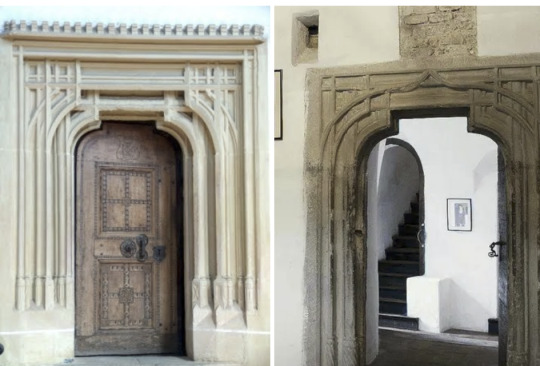
The left pic's Biertan Fortified Church, in Sibiu (south Transylvania). (Another door.) The right pic's Bran Castle, in Brasov (south Transylvania). (Another door.) (Vlad Tepes/Dracula historically never owned this castle, but pop culture says otherwise.) Both places were built by the German/Saxon Transylvanians in the 14th-16th centuries; which might help date Daciana's castle, if not Daciana herself? (The Saxon Transylvanians were in Wallachia, too.)
Wall Ornamentation
The last thing I'll discuss is the wall ornamentation/decoration:
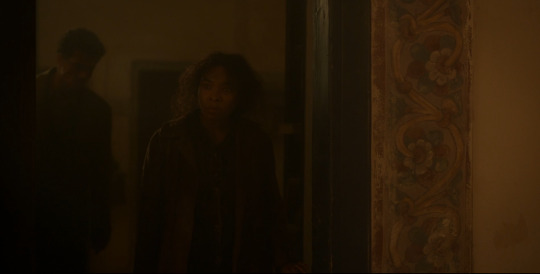
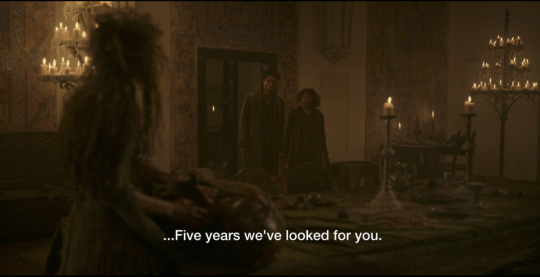
The painted floral trim everywhere instantly reminded me of The Witcher 3, as found in Hungarian, Polish, Ukranian etc buildings. Apparently the designs are all related to fertility, growth/luck, and the Tree of Life. Walls (X X X) and doors (X X) were painted. You can see northern Romanian painted ornamentation in Suceava (Bukovina).

There's painted wall designs in southern Romania, too.
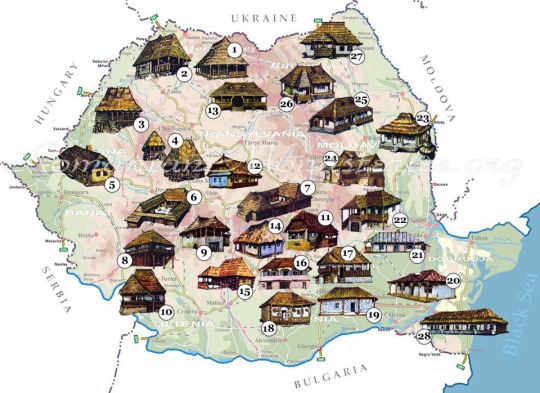
"The research of the popular interior in the Argeş and Muscel areas leads to the determination, along with a local specificity, and some Transylvanian influences, in the contact areas between southern Transylvania and northern Muntenia. In the researched areas, two lines of development of the popular interior can be observed, one relatively simple and the other complex. If the first is the prerogative of a typical Subcarpathian interior, the second represents a distinctly Transylvanian form, which was also imposed due to the presence of the Transylvanian population in the south of the Carpathians, settled in numerous villages." -- (Google Translated from Arta populară din zonele Argeș și Muscel, 1967)
(The website RomaniaDacia has A LOT to say about Transylvania, and the impact of the Germans, Saxons, Hungarians, etc on Wallachia & the rest of Romania.)
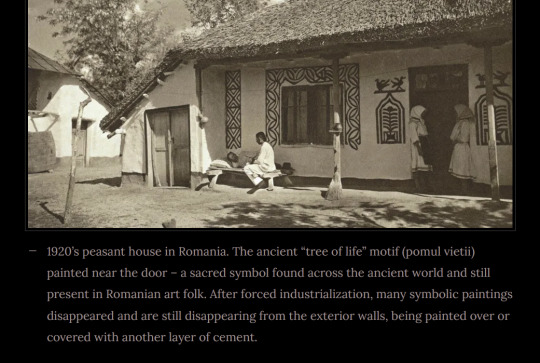
Sure enough, I was finding way more carved ornamentation (X X X X X X) than painted ones.
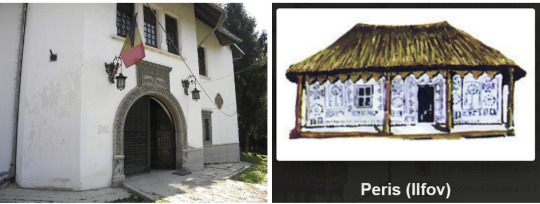
But I wonder if that's why a lot of southern traditional Romanian interiors I've been finding have totally plain whitewashed walls, too, with no painted ornaments, just tapestries (X X). I did find Romanian interior floral wall painted trims (X), but not nearly as much.
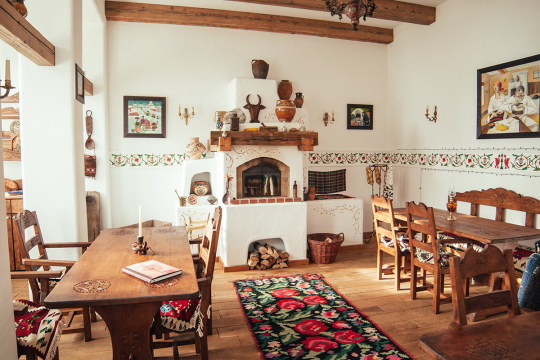
Cuz actually, the closest comparanda I was finding for Daciana was Northern European rosemaling (X X), which is also giving me medieval vibes (X); specifically: trims on illuminated manuscripts like the Book of Hours (X X X)--which we know from Lestat in S01E06.
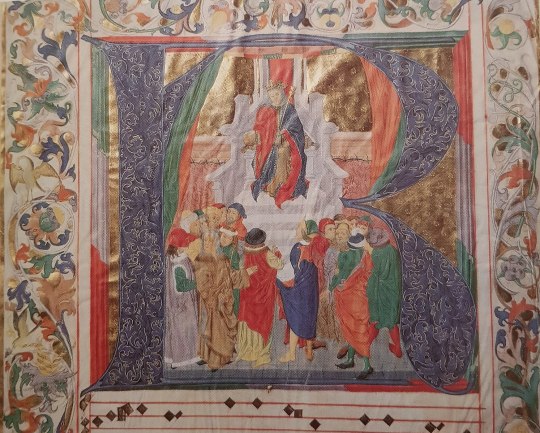
And we do see some Romanian medieval fresco borders & frescoes that had been plastered over & whitewashed, in Biertan's 15th century churches, and in 13th-15th century Darjiu (Transylvania).
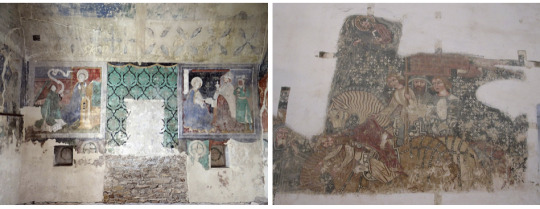
So, I wouldn't be surprised if a lot of Romanian buildings (especially castles with whitewashed plastered walls) were formerly painted similar to Daciana's. Unfortunately, I just can't find an example or figure out what AMC might've been inspired by--Romania has hundreds of castles & churches.
So, I'm tapping out--this is the most I could find so far. U_U
Results? Inconclusive! 😭 My Google-fu has failed me, LOL!
I still have no idea what time period Daciana could be from. We could go several routes:
Go by her name, and say she's ooooold AF, an actual Dacian. She's just been collating Eastern European culture as she ages, but stopped at some point (as her mind deteriorated)
She's medieval, somewhere roundabouts the 14th-16th century (making her ~500 years old, the same age as Armand--but she's weaker (as I've theorized b4), which is why she was able to burn herself up.)
Settle on her being a local Wallachian from Southern Romania, likely pre-19th century / pre-industrial early-modern Europe
Handwave everything aside as Renn-Faire fairytale fantasy; let the tale seduce you~!
OR, we can just bully AMC until they give us an extended BTS look at how Daciana was conceptualized, telling us all the tea about her! 😈
#interview with the vampire#iwtv tvc metas#fashion history#architecture#medieval europe#read a dang history book#the vampire daciana
91 notes
·
View notes
Text
What's more culturally significant, the Renaissance, or Donna Noble having a trans daughter?
#doctor who#doctor who spoilers#donna noble#rose temple noble#philomena cunk#cunk on earth#trans#fourteenth doctor
310 notes
·
View notes
Text
What was more culturally significant: this panel of Genya in HD or the renaissance


540 notes
·
View notes
Text
whats more culturally significant the renaissance or ethan being cast as remus for mischief productions
25 notes
·
View notes